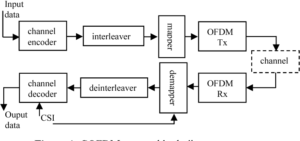cdofdmThe following sections will explain and compare COFDM with other modulation techniques. It will explain how COFDM works and provide a detailed analysis and comparison of its performance with different modulation schemes.
COFDM is a type of multicarrier modulation, which is a form of modulation that encodes data onto multiple carrier frequencies. COFDM is an attractive choice for modulation because it is very resistant to multipath interference. Multipath interference is caused by signals reflecting off objects and multiple paths reaching the receiver. This can cause problems for other modulation schemes, but COFDM is designed to resist it.
COFDM works by subdividing the available frequency spectrum into several subcarriers. Each subcarrier is then modulated with a conventional modulation scheme, such as QPSK or QAM. The data from all of the subcarriers are then combined and transmitted.

COFDM advantages
COFDM has several advantages over other modulation schemes. One advantage is that it is very resistant to multipath interference. Another advantage is that it is very spectrally efficient, meaning it can pack a lot of data into a small amount of bandwidth. COFDM also has a very low out-of-band emission, meaning it doesn’t produce a lot of unwanted signals outside of the desired frequency band.
COFDM does have some disadvantages, however. One drawback is that it is more complex than other modulation schemes. This complexity can make it more challenging to implement, and it can also make it more expensive. Another disadvantage is that Coded orthogonal frequency-division multiplexing is more susceptible to frequency-selective fading than other modulation schemes. This means that signals can be lost if they are faded on one of the subcarriers but not the others.
Overall, COFDM is a beautiful modulation scheme for several reasons. It is very resistant to multipath interference, is very spectrally efficient, and has low out-of-band emission. However, it is more complex than other modulation schemes and more susceptible to frequency-selective fading.
What is Coded orthogonal frequency-division multiplexing?
COFDM is a form of modulation used in many modern communication systems. It is an attractive modulation technique because it provides a high degree of immunity to fading and multipath effects.
COFDM is a multicarrier modulation technique that encodes data onto multiple carrier frequencies. Each carrier is modulated with a conventional modulation scheme (usually QAM or PSK). The pages are then combined to form the final signal.

COFDM has several advantages over other modulation techniques.
COFDM is resistant to fading and multipath effects
The COFDM signals are less susceptible to fading and multipath effects than other modulation techniques. This is because each carrier is only affected by a small portion of the total fading and multipath power.
Coded orthogonal frequency-division multiplexing provides a high degree of immunity to interference
COFDM signals are less susceptible to interference than other modulation techniques. This is because each carrier is only affected by a small portion of the total interference power.
Coded orthogonal frequency-division multiplexing requires a relatively small amount of bandwidth
Coded orthogonal frequency-division multiplexing signals can be transmitted using a relatively small amount of bandwidth. Each carrier only needs to be modulated with a low data rate.
Coded orthogonal frequency-division multiplexing can be implemented using a variety of modulation schemes
Coded orthogonal frequency-division multiplexing can be implemented using a variety of modulation schemes, including QAM and PSK. This allows COFDM to be tailored to the specific needs of each application.
Coded orthogonal frequency-division multiplexing is an attractive modulation technique for many modern communication systems. It is resistant to fading, and multipath effects provide a high degree of immunity to interference and require a relatively small amount of bandwidth. Coded orthogonal frequency-division multiplexing can be implemented using a variety of modulation schemes, making it a versatile modulation technique.

How does Coded orthogonal frequency-division multiplexing work?
Coded orthogonal frequency-division multiplexing has a very high throughput, thanks to its use of multiple sub-carriers. This means that more data can be transmitted in a given amount of time, which is ideal for applications that require high data rates.
Coded orthogonal frequency-division multiplexing also has very low latency because each sub-carrier is transmitted simultaneously. It contrasts other modulation techniques, which communicate each sub-carrier sequentially.
Coded orthogonal frequency-division multiplexing is very robust to channel conditions, such as multipath fading. COFDM uses a guard interval, ensuring each symbol is received correctly.

Efficiency
Coded orthogonal frequency-division multiplexing is very efficient in power consumption, thanks to its use of multiple sub-carriers. This means less power is required to transmit a given amount of data.
Coded orthogonal frequency-division multiplexing is more expensive to implement than other modulation techniques because it requires more hardware. This is because each sub-carrier must be modulated and demodulated separately.




